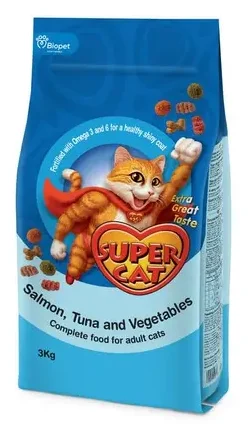Super Cat
Salmon, Tuna & Vegetables
Adult
Regular
Indoor and Outdoor
Click to reveal the score breakdown
Tap to view ingredients, guaranteed analysis and more
Ingredients
Cereals
Meats and animal by-products
Vegetable by-products
Oils and fats
Fish and fish by-products (4% salmon in kibbles with salmon, 4% tuna in kibbles with tuna)
Vitamins
Minerals
Vegetables (4% carrots in kibbles with carrots, 4% green vegetables in kibbles with green vegetables)
Yeasts
Antioxidants
and also:
Colorants
Vitamins and Additives
Vitamin A 30.000 ui/kg
Vitamin D 1500 ui/kg
and also:
Iron (94mg/kg), Zinc (94mg/kg), Copper (6mg/kg), Manganese (7mg/kg), Iodium (0.9mg/kg), Selenium (0.14mg/kg), Taurine (1000mg/kg)
Guaranteed Analysis
Crude Protein
30%
Crude Fat
10%
Crude Fiber
3.5%
Moisture
10%
Crude Ash
8.5%
Metabolizable Energy
3590 kcal/kg
Product last updated: May 15, 2024, 2:23 PM
Please hold on while we’re getting the best offers for you
6794


